What’s Up?
Monday morning turned out rather nice weather-wise. It was quite still early, with some sweet light as the sun occasionally broke through the clouds. I started with a few images of my favorite crane family. Then after driving around a bit scouting, created a nice bird-scape or two of a Great Blue Heron on the edge of a canal. By the time I walked the pier at about 8:30am there was a gentle breeze from the northwest. There was a silly-tame Turkey Vulture on the pier railing that let me get closer than I ever have to any vulture. I would get really close and the bird would scamper away a few feet. There was a Bald Eagle sitting on the railing farther along. For some strange reason, the scampering vulture made the eagle somewhat comfortable with my presence. I made lots of tight head and shoulders portraits of the vulture but would up deleting every single one because the bird’s back was covered with whitewash. Vultures often poop on other vultures when they are roosting.
Anywho, with the sun in the southeast and the wind from the northwest the eagle took flight. I made a single good frame of the eagle gliding away over still blue water. I will likely share that with you here tomorrow. I did my swim with my neoprene vest. By late Monday, the clouds had taken over. I stayed in.
He today is another opportunity to look at some more great images. If you have a moment, please leave a comment and let us know which of Geoff’s five images you think is the strongest, and why you made your choice.
I was glad to learn yesterday that William Dummitt sold his Sigma 500mm f/4.5 APO EX HSM lens for Nikon mount in excellent condition for a very low $699.00 (was $899.00) and a Nikon AF-S NIKKOR 24-120mm f/4G ED VR lens in excellent condition for a BAA record-low $399.00 (was $498.00) in late-December 2020.
Today is Tuesday 12 January 2021. As it is cloudy-dark at 7:30, I will probably stay in this morning to get some work done. This blog past makes twenty-three days in a row with a new blog post. This one took about three hours to prepare. Please remember …
Please Remember
With income from IPTs approaching zero, please, if you enjoy and learn from the blog, remember to use one of my two affiliate programs when purchasing new gear. Doing so just might make it possible for me to avoid having to try to get a job as a Walmart greeter and will not cost you a single penny more. And if you use Bedfords and remember to enter the BIRDSASART code at checkout, you will save 3% on every order and enjoy free second-day air shipping. In these crazy times — I am out at least forty to sixty thousand dollars so far due to COVID 19 (with lots more to come) — remembering to use my B&H link or to shop at Bedfords will help me out a ton and be greatly appreciated. Overseas folks who cannot order from the US because of import fees, duties, and taxes can always help out by clicking here if they see fit.
Via e-Mail from Bill Dummitt
Hi Artie, Everything sold! Thank you for the help with pricing and selling all the lenses. It was invaluable. Some happy folks now own ew lenses and I am almost 4K to the good. Bill
The BAA Used Gear Page
The Used Gear page continues to be very active. The BAA Used Gear Page is the place to sell your used photographic equipment. We will help you to get your gear sold quickly for 20 to 60% or more than what the big guys are offering … Doubt me? Check out the Recent Sales list for the past eleven months at the bottom of the page.
RawDigger e-Guide and Video Advance Copy Available
Save $10 Now
The RawDigger e-Guide and Video is almost finished. It will sell for $51.00. If you are anxious to get started with RawDigger, learn to mega-Expose to the Right, and wind up with the highest quality image files, you can save $10.00 and have a chance to review a pre-publication copy of the guide by sending a PayPal for $41.00 to birdsasart@verizon.net with the words RawDigger e-Guide and Video Pre-publication Copy cut and pasted into the Subject line. The recent delay is the result of my recent conversations with Iliah Borg, the brains behind RawDigger. It is very likely that the Shock-your-World section will shock you.
In the new guide, we teach you why the GREEN channel is almost always the first to over-expose. We teach you how to interpret the Max G values. And most recently, we teach you a simple way to evaluate your exposures using an adapted RawDigger histogram. And tons more, of course. I am planning on having the RawDigger guide ready for sale by next Monday. Folks who saved $10.00 by pre-ordering will of course receive a link to the final PDF.
Canon R5/R6 AF e-Guide Info
So far, 70 folks have sent PayPals for their copy of the Canon R5/R6 AF e-Guide. And 28 who used my affiliate links to purchase their R5 have e-mailed for and received their free copy of the guide. If you e-mailed or sent a PayPal and did not receive your guide, please LMK immediately via e-mail.
Feedback has been overwhelmingly positive so far. Three folks wrote stating that they had a better way of setting up AF on their R5s. When I wrote back explaining why they were in error, two of them back-tracked. One stubborn guy is still doing it his way — less efficiently. Be sure to scroll down to read about my plans for a Canon R5/R6 User’s e-Guide. Understand that the info in the BAA Canon R5/R6 Autofocus e-Guide is so important that I opted to publish the AF guide immediately as the R5/R6 User’s Guide will take at least a month to finish.
BAA Canon R5/R6 Autofocus e-Guide
Twenty-one pages. 3,452 words. 28-DPP4 screen captures showing the R5’s vaunted AF system in action. Note: the AF system of the R5 is identical to the AF system of the R6.
You will learn:
1- The two most useful AF Methods for general bird photography and for birds in flight.
2- How to set up your R5/R6 AF Menus.
3- What boxes to check (and un-check) under Limit AF Methods.
4- How to change the AF Method quickly, easily, and efficiently. Note: the default way of doing this is clunky, cumbersome, and inefficient at best. One person replied that this tip alone was worth the price of admission.
5- The only setting that should be used for Initial Servo AF pt for Face Detection + Tracking.
I you are currently using multiple back buttons either for general bird photography or for birds in flight, what you learn in this guide will change your life. For the better.
Here are the first three paragraphs of this e-Guide:
From the moment I learned about the new Canon mirrorless bodies, I read about using two or three back-buttons to focus using different AF methods. The word on the street said that the way to go for birds in flight was to use one button to acquire focus with Zone AF or with Large Zone: Horizontal AF and then switch to another button to activate Face Detection + Tracking AF and then use the shutter button to make an image. My immediate thought was, “This is insanity! There has got to be a better way.” In short, there is a far superior way to set up AF on your R5 or R6.
Remember that I got away from any form of back-button or rear focusing many years ago after finally realizing that it is always easier to do one thing (press the shutter button), than it is to do two things (press a back button and then press the shutter button).
The default method of switching AF Methods with the R5/R6 bodies is cumbersome at best. It involves first pressing the grid button (my name) on the upper right back of the camera and then pressing the hard-to-access M-Fn button to toggle through the AF Methods. This method is so bad that it will not be mentioned again in this guide.
The guide is free to all who have ordered an R5 or an R6 using my B&H affiliate link or from Steve Elkins/Bedfords using the BIRDSASART coupon code at checkout. Please send your receipt to me via e-mail. It will take me a few days to a week to verify the B&H purchases. Bedfords folks should expect their free e-Guides fairly quickly.
To purchase your copy of the e-Guide, please send a PayPal for $25.00 to birdsasart@verizon.net and be sure to include the words R5/R6 AF Guide in your PayPal e-mail.
Everyone who gets the guide will receive a free update no later than the first week in January.
Canon R5/R6 User’s e-Guide
I am working on a complete Canon R5/R6 User’s e-Guide. This will require a lot of research, a lot of time, and a lot of effort. I am hoping to have it complete by mid- to late January. As always, folks who use the BAA affiliate links to purchase their Canon gear will receive a substantial discount.
Understand that the info in the BAA Canon R5/R6 Autofocus e-Guide is so important that I opted to publish the AF guide right off the bat to help folks get started with their new camera bodies.
Great Topaz News!
Folks who use the BAA Topaz link to purchase Sharpen AI, DeNoise AI, or the Utility Bundle (or any other Topaz plugins) will receive a 15% discount by entering the ARTHUR15 code at checkout. To get the discount you must use my link and you must enter the discount code. Be sure to start with this link.
Topaz Stuff
As I said just a while back and have said often many times before, I should have listened sooner. If you, like me, are new to the Topaz party, please use this link to purchase. Right now I can wholeheartedly recommend both Topaz Sharpen AI and Topaz DeNoise AI. Though I have not yet worked with JPEGtoRAW AI or Gigapixel AI, I have installed both of these plug-ins and look forward to trying them on some I-Phone 11 images fairly soon. If you are thinking like me, consider the Utility Bundle that includes all four plug-ins mentioned above at a money-saving price.
Again, those who purchase Sharpen AI or DeNoise AI using my link, can e-mail to request a short Getting Started with Topaz e-Guide. I had a bit of trouble getting the two plug-ins installed and having them appear in the Photoshop Filter Menu. In addition, I will explain how to best learn about the two plug-ins by applying them on a Layer (in Photoshop).
|
|
|
132 sold to rave reviews. The SONY e-Guide by Patrick Sparkman and Arthur Morris |
The Sony Camera User’s e-Guide (and Videos)
Click here to purchase the guide with one Camera Set-up Video. Be sure to e-mail us by clicking here to specify your camera body so that we can send you a link for the correct video.
Click here to purchase the guide with two Camera Set-up Videos. Be sure to e-mail us by clicking here to specify your two camera bodies so that we can send you links for the correct videos.
Click here to learn more about the SONY e-Guide.
Folks who have used my B&H affiliate links or purchased their SONY gear are invited to e-mail for discount information.
New and Better Bedfords Discount Policy!
You can now save 3% on all of your Bedfords photo gear purchases by entering the BIRDSASART coupon code at checkout. Your discount will be applied to your pre-tax total. In addition, by using the code you will get 2nd day air shipping via Fed Ex.
Grab a Nikon AF-S Teleconverter TC-14E III and save $14.99. Purchase a Canon EOS R5 and your discount will be $116.97. Purchase a Sony FE 600mm f/4 GM OSS lens and save a remarkable $389.94! Your Bedford’s purchase no longer needs to be greater than $1,000.00 for you to receive a discount. The more you spend, the more you save.
Money Saving Reminder
Many have learned that if you need a hot photo item that is out of stock at B&H and would enjoy free overnight shipping, your best bet is to click here, place an order with Bedfords, and enter the coupon code BIRDSASART at checkout. If an item is out of stock, contact Steve Elkins via e-mail or on his cell phone at (479) 381-2592 (Central time). Be sure to mention the BIRDSASART coupon code and use it for your online order to save 3% and enjoy free 2nd-day air shipping. Steve has been great at getting folks the hot items that are out of stock at B&H and everywhere else. The wait lists at the big stores can be a year or longer for the hard to get items. Steve will surely get you your gear long before that. For the past year, he has been helping BAA Blog folks get their hands on items like the SONY a9 ii, the SONY 200-600 G OSS lens, the Canon EOS R5, the Canon RF 100-500mm lens, and the Nikon 500mm PF. Steve is personable, helpful, and eager to please.


Gear Questions and Advice
Too many folks attending BAA IPTs (remember those?) and dozens of photographers whom I see in the field and on BPN, are–out of ignorance–using the wrong gear especially when it comes to tripods and more especially, tripod heads… Please know that I am always glad to answer your gear questions via e-mail. Those questions might deal with systems, camera bodies, accessories, and/or lens choices and decisions.
|
|
|
This image was created by Geoff Newhouse in Vancouver, British Columbia, Canada. He used the handheld Sony FE 600mm f/4 GM OSS lens, Sony FE 1.4x teleconverter, and the blazingly fast AF King, the Sony Alpha a9 II Mirrorless Digital Camera Body. ISO 1250: 1/3200 sec. at f/5.6 in Manual mode. Center Zone AF-C was active at the moment of exposure and performed to perfection. Click the image to see the spectacular larger version. Image courtesy of and copyright 2020: Geoff Newhouse Image #1: Short-eared Owl looking down the lens barrel flight |
Thanks to Brian Sump
Thanks to Brian Sump for shooting me a link to the fine work of Photographer Geoff Newhouse.
Geoff Newhouse
Geoff grew up in the interior of British Columbia, did university at UBC in Vancouver, and worked in Alberta after graduation. He got into photography with his first Canon Rebel DLSR in early 2009 after from moving from Alberta to Whitehorse, Yukon Territory. His focus soon changed from general outdoor photography to bird and wildlife photography after a trip to Galapagos in 2011. His interest in bird photography surged after he located two eagle nests at eye level; he spent four years photographing eagle nesting behaviour. One of his eagle images was highly-honoured in the 2017 Nature’s Best Photography Contest/Bird category in 2017. Scroll down in the gallery here to see his Eagles Feeding Eaglet image. After that, he spent most of his vacation time traveling to Antarctica, Borneo, Ecuador, Costa Rica, and Florida photographing birds.
Geoff started with Canon and added some Nikon gear in late 2016. He soon switched mostly to Nikon but then added a Sony A9 in 2017. He sold off the last of his Canon gear in 2019. He still has a bit of Nikon gear but went predominantly to the Sony a9 ii, a7r iv, 200-600 G, and the 600mm f/4 GM for the past few years. The R5’s Face Detection + Tracking “bird eye” AF was too tempting to pass up, so he recently added the mirrorless EOS R5 to his kit. He wishes that he’d kept at least one of his big Canon EF super-telephoto lenses to use with the R5 and an EF adapter. His plan is to use the RF 100-500 until Canon releases some larger RF prime lenses. (Does his gear story sound familiar?)
In August of 2018 he moved from the Yukon to Vancouver Island in the Victoria, BC area. There he discovered lots of new and different avian subjects to photograph relatively close to home. As there is not any significant winter on the island, he is able to do lots of bird photography year-round. He plans to live there until he retires.
Geoff was a great help with the R5/R6 AF Guide. You can see more of his excellent work on his Flickr Photostream here.
|
|
|
This image was created by Geoff Newhouse in Vancouver, British Columbia, Canada. He used the handheld Sony FE 600mm f/4 GM OSS lens, Sony FE 1.4x teleconverter, and the blazingly fast AF King, the Sony Alpha a9 II Mirrorless Digital Camera Body. ISO 640: 1/4000 sec. at f/5.6 in Manual mode. Center Zone AF-C was active at the moment of exposure and performed to perfection. Click the image to see a larger version. Image courtesy of and copyright 2020: Geoff Newhouse Image #2: Short-eared Owl flight flight side view
|
Two-Gun Geoff
So why “Two-Gun Geoff?” Geoff is currently using both the SONY 600 GM/a9 ii and the Canon RF 100-500/R5 rigs. The first two of today’s featured images were created with is SONY 600 GM, the 1.4X TC, and the a9 ii. Image 3 & 4 were created with his Canon gear. All of these excellent images (and lots more), were created on a single great day of photography — 4 December 2020!
The Real “Two-Gun Pete”
“Two-Gun Pete” Washington was a legendary Chicago police officer who is said to have been responsible for more than 20,000 arrests. He had 9 notches on the two 357 Magnums that he carried on his South Side beat between 1933 and 1951.
About the book “Chicago’s Two-Gun Pete by Jerry Jones (now out of print), a reviewer named Peter wrote:
A very interesting history of a Black Chicago Cop that spanned from the 1930’s to the 50’s. He one time had patrolled both the South and West sides of the city. Sylvester “Two-Gun” started his career as an anonymous blue-coated Chicago beat cop, but he ended up as a neighborhood superstar! He was a flamboyant, hard-drinking, crooked, braggadocious, womanizing, foul-mouthed Chicago Police detective.
He was tasked with clearing out bad elements from every nightclub, whorehouse, flophouse, jazz club, and pool hall in what was then called the Black Metropolis, aka “Broneville” on Chicago’s the South Side. This Black Belt was mired in poverty, violence, corruption, substandard housing and was the home to 3/4 of Chicago’s Black population. Which kept growing, with waves of Blacks arriving on the Illinois Gulf Central trains from the deep southern states. Washington spent most of his career working out of the old Wabash Avenue Police Station located at 48th Street and Wabash Avenue. By the mid-1940s, his 5th District, with a population of 200,000, led the city in slayings, robberies, rapes, and had gained the nickname the “Bucket of Blood.”
But the mention of Two-Gun Pete’s name could clear a street corner in seconds. “Everybody knew Sylvester Washington,” said Rudy Nimocks, a former Deputy Superintendent. “They knew his car. And the prostitutes would go hide someplace when they saw him. He was something else.” Washington and his pistols were even featured in a small photo in a 1947 issue of Life magazine. At the height of his legend, he didn’t even have to unholster his guns. He would send troublemakers unescorted to the police station, and they would go, preferring not to have Pete come looking for them later.
|
|
|
This image was created by Geoff Newhouse in Vancouver, British Columbia, Canada. He used the handheld Sony FE 600mm f/4 GM OSS lens, Sony FE 1.4x teleconverter, and the blazingly fast AF King, the Sony Alpha a9 II Mirrorless Digital Camera Body. ISO 640: 1/4000 sec. at f/5.6 in Manual mode. Center Zone AF-C was active at the moment of exposure and performed to perfection. Click the image to see a larger version. Image courtesy of and copyright 2020: Geoff Newhouse Image #3: Short-eared Owl staring flight
|
Staring in Flight!
I found this one in Geoff’s Flickr Photostream gallery after my morning walk and decided that I had to add it to the blog post. So I did.
|
|
|
This image was created by Geoff Newhouse in Vancouver, British Columbia, Canada. He used the handheld Canon RF 100-500mm f/4.5-7.1L IS USM lens (at 500mm) and the highly touted 45MP Canon EOS R5 Mirrorless Digital camera body. ISO 800: 1/2500 sec. at f/7.1 in Manual mode. Image courtesy of and copyright 2020: Geoff Newhouse Image #4: Short-eared Owl flight banking top shot |
R5 Crop-ability
Geoff kindly sent me DPP 4 screen captures for both of the Canon images here (and several more from the series during which Image #4 (below) was created. With 45 megapixels, sharp R5 images can stand up to healthy crops. I’d estimate that for Image #3 more than 75% of the original pixels were cropped away yet the image quality looks just fine.
The screen capture for this image showed that Face Detection + Tracking AF for this image reverted to what I would call full-screen AF with 910 AF points (or areas?) available. In any case, the system activated an irregular pattern of 8 AF points. One caught the top of the owl’s head. The other seven points painted the far wing. Keep reading for my additional comments on Face Detection + Tracking AF.
|
|
|
This image was created by Geoff Newhouse in Vancouver, British Columbia, Canada. He used the handheld Canon RF 100-500mm f/4.5-7.1L IS USM lens (at 500mm) and the highly touted 45MP Canon EOS R5 Mirrorless Digital camera body. ISO 800: 1/2500 sec. at f/7.1 in Manual mode. Image courtesy of and copyright 2020: Geoff Newhouse Image #5: Short-eared Owl starting dive |
The Attack!
As you can see by looking at the screen capture below, this is another large crop. It is from a five-frame sequence where a second short-eared flew in to attack the bird that Geoff was photographing. Geoff wisely kept firing. The bird in Image #4 was diving away from the attacking bird.
|
|
|
DPP 4 screen capture courtesy of and copyright 2020: Geoff Newhouse Image #5A: DPP 4 screen capture for Short-eared Owl flight |
Getting Lucky
By Geoff’s own admission, he got lucky here. The AF system tracked the attacking bird. Though the active AF point was nowhere near the bird that would become the subject, both birds were on the same plane. Thus, the bird featured in Image #4 is quite sharp on the eye. Such lucky accidents happen with all AF systems. I have made sharp flight images with Canon, Nikon, and SONY where the AF point was on the sky rather than the subject.
R5 Face Detection + Tracking AF
Part of the reason that I was curious about the R5 were statements to this effect: The R5’s Face Detection + Tracking AF never fails. The system sees the bird’s eye even before you press the shutter button, locks onto the eye, and never lets go.
I will readily admit that this technology is nothing short of amazing. I have seen it track the eye of a-small-in-the-frame subject perfectly for multiple in-flight frames. But having worked with the R5 for five weeks, and having seen Geoff’s DPP 4 screen captures, I can state with absolute confidence that the R5’s Face Detection + Tracking AF is nowhere near perfect. It will, at times — with subjects ranging from tiny-in-the-frame to large-in-the-frame — fail to track the a subjects eye (even after first acquiring it successfully). When eye AF is tracking perfectly the AF point transforms to a tiny square. As detailed in the R5/R6 AF Guide, this technology may often revert to a small square, to a medium-sized square, a large square, or to activating multiple AF points (as we saw with Image #3).
In short, the R5’s Face Detection + Tracking AF technology is amazing, but it is far from perfect even in highly skilled hands like Geoff’s.
Typos
In all blog posts and Bulletins, feel free to e-mail or to leave a comment regarding any typos or errors.

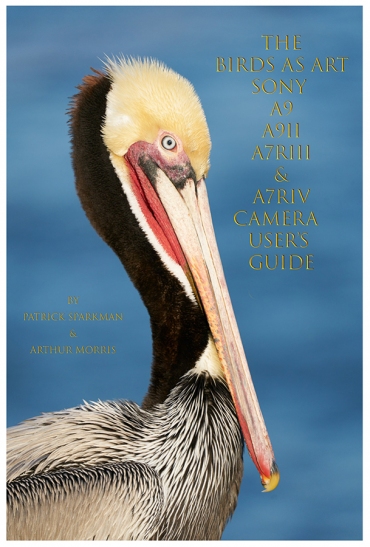

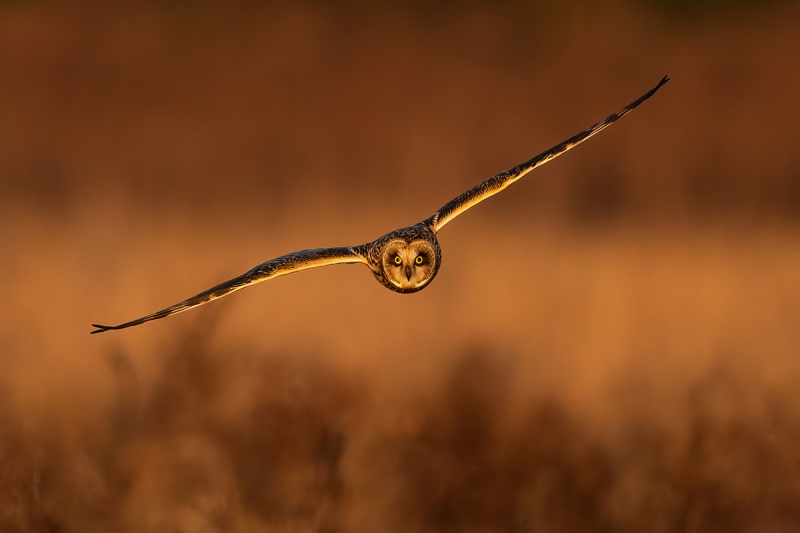
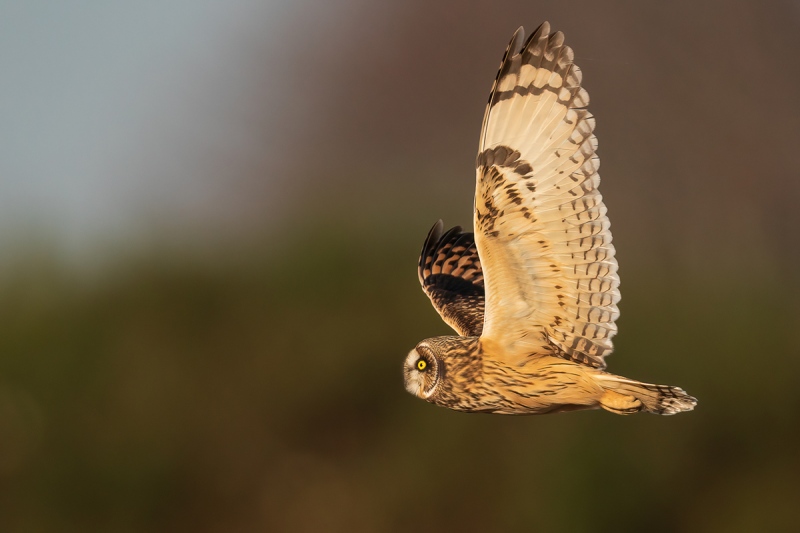
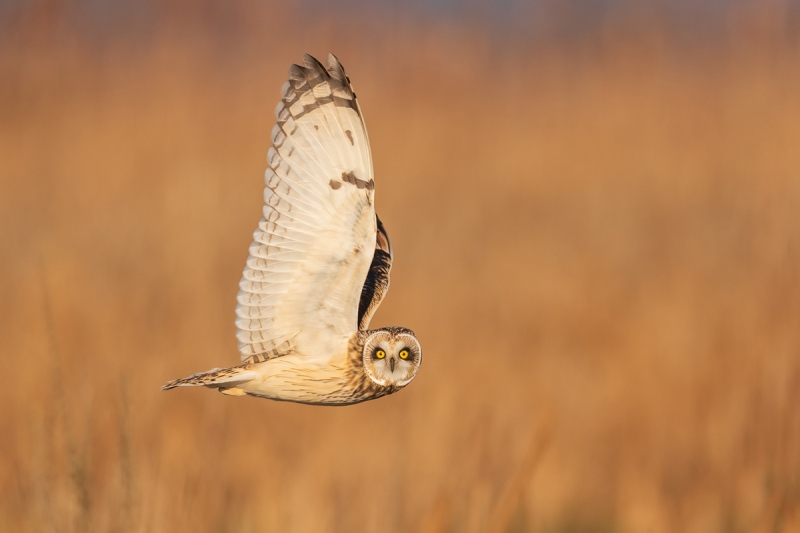
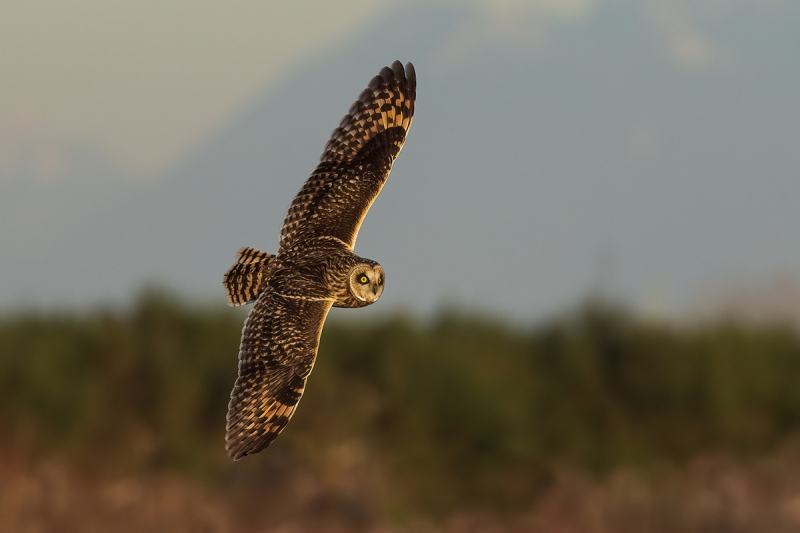
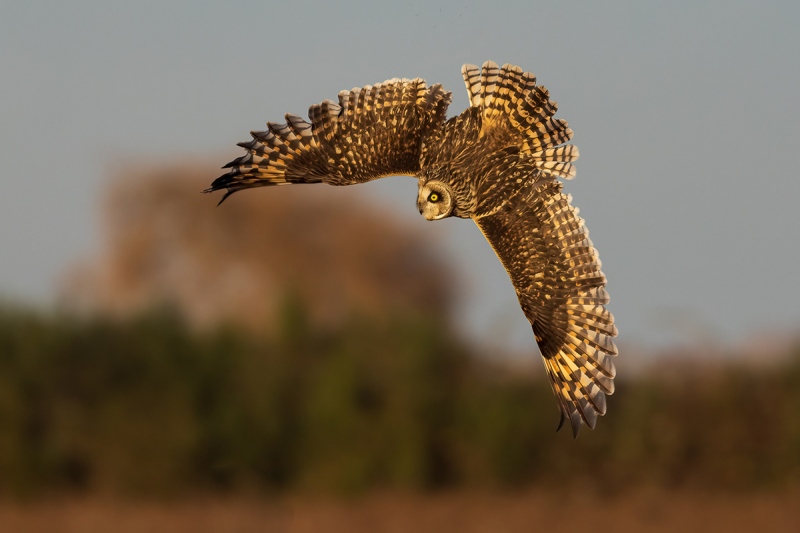
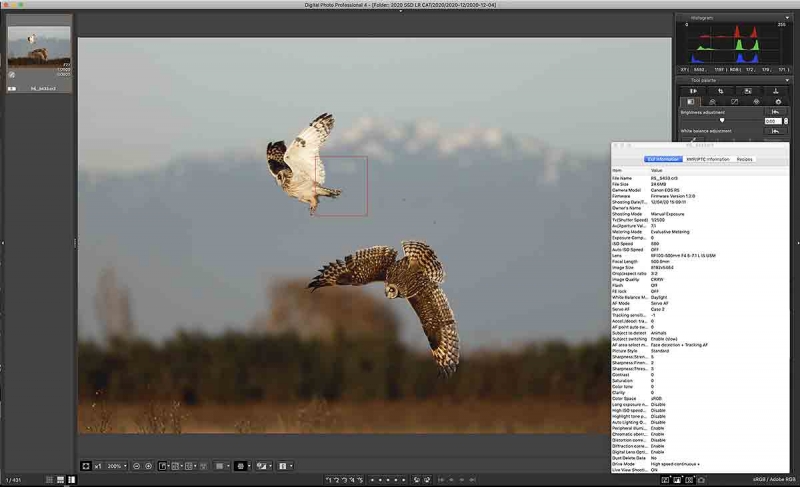













It is good to hear what Geoff has to say about the Canon R5. I find it to be terrific, but it certainly is not perfect at eye detection like on moose or elk. It does well on most birds, though, and I hope really well when I get to do my floating blind birds again (right now my lakes are a little hard.) And this R5 really shines for landscape and close-up images. Keep up the comparisons. I am hoping when the successor to the R5 becomes available, eye detection will be a level or two better.
Love the flight angle and feather spread on # 5
Hi Artie,
#1 and #3 for me also. Really like the background in #1. Great work! Both images remind me of watching short ears at Jake’s Landing Road in Cape May years ago.
The link to Natures Best Photography is humbling. Have to get out in the field tomorrow!
Enjoy,
Joe
AM: Did Geoff tell you whether he prefers one rig over the other for BIF? This seems like the perfect test –similar focal lengths, same day, same photographer.
Not the same focal lengths at all. 840 versus a max of 500 with the RF 100-500. Not to mention 840mm at f/5.6 is way better than 500 at f/7.1. But a lot heavier and a lot more expensive. I will ask Geoff. For me the answer would be SONY by a mile for birds in flight and everything else as well.
When is your birthday???
with love, artie
Hi David,
Both combinations got me lots and lots of sharp images. As Artie points out the 840mm on a 24MP A9II sensor is still more “reach” than the 500mm on the 45MP R5 sensor. The pixel density difference between those two sensors works out to just a little less than 1.4x. So the 500mm on the Canon would be about the same as a 700mm lens on the Sony. But with the Sony you get a FF 24MPs of big, high quality pixels and with the R5 you are cropping into smaller pixels to even be “equivalent”. I always prefer a longer lens on a ~20 odd MP sensor over cropping into a high-density sensor with a shorter lens. But in good light like I had for the owls it doesn’t matter as much.
My current opinion between the two systems is for birds on a stick, birds in the bush and birds on the water the R5’s Eye-AF is my preferred method as I can get onto a subject faster and also it allows me to just focus on recomposing and let the Eye-AF do its thing. However, for BIF I still give the edge to the A9/A9II. I just trust it a little more. But it takes smaller, faster and more erratic birds in flight to really make a difference. One of the toughest subjects I photograph are Violet-Green Swallows in flight but they had migrated out before I got the R5 so I’m waiting for March/April to give the R5 a true test on them. My opinion may change after trying on them.
For the owls they fly slow enough and predictable enough that both systems did really well. Although one difference I noticed is when the owls went down into the cattails (you can see some shots on my Flickr where they are flying through them) the R5 had more of a tendency to loose the owl and grab cattails. Only if the R5 could see the eye (and the owl didn’t turn its head away) did it stay on the owl as well as the A9II did in the same situation. The A9II lost it to the cattails sometimes but not as often. The A9II seemed to just continue dancing the green dots on the owl as it went into the cattails even though I wasn’t using the Real-Time Tracking mode. I almost always use regular (non-tracking) Zone or Wide for my flight shots on the A9II. On the R5 I was mostly using Eye-AF/Subject Tracking or reverted to Center Zone if the Subject Tracking wasn’t working.
If someone is already heavily invested in Canon lenses I’d just go Canon R5 (R6). If someone is already shooting Sony I’d certainly stay put. The next Sony bodies may have just as good Bird Eye-AF (or better) than the R5. Sony’s had a year or two now to further develop that system. Even as it stands now I can get the Sony Eye-AF to engage on some ducks when they fill most of the frame (it loves N. Pintails) and Song Sparrows seem to work well. The Sony Eye-AF also works on owls easily when perched and a decent size in the frame but not when flying. I think they will surpass R5 in the next A9 body. The current rumors are calling for a 50MP A9(R?) in the next month of so. That could kill the R5 (or not…who knows). So if already a Sony shooter I wouldn’t be spending on the R5 right now…save that $$ for the next A9.
#1 for me with #5 a close second. The color, composition and the eyes put the first image over the top for me. This would make a very nice large print.
Image #1 followed by #3 simply because of the eyes followed by color and background. Yes, the R5’s AF is not perfect by any stretch of the imagination and the accuracy and capabilities are highly variable depending on the lighting and subject. The other day, I was photographing Sandhill Cranes on sun angle in the late afternoon from a reasonably close vantage point with a long FL lens. The camera was struggling a bit particularly when the eyes became iridescent in the sun. If the bird looked away for a millisecond, the af would jump to the body and not release even when the bird looked back. Typically, I had to rapidly go back to single point, recapture the AF on the eye and then rapidly changed back to Face+Tracking, to re-engage the tracking. This was worse in portrait as opposed to landscape orientation. On other days, particularly cloudy ones – which we have no shortage of here in the Midwest – the AF is just dandy and these issues are rarely encountered. The bottom line is that to be successful, one has to understand the limitations of the system and be able to work around the challenges when they present themselves.
Thanks as always, Adam. I should have mentioned the the greater the skill of the person holding the R5 and a super-telephoto lens, the better Face Detection + Tracking will perform. Please do not include me in that group 🙂
with love, a
Yes I’ve noticed by watching the pre-AF white indicators that Eye-AF and even just subject AF often can take a few seconds to figure things out and detect the subject, head or eye. The cleaner the background, the steadier the camera/lens is held and the lighting on the bird all make a difference in how fast the system finds the subject.
I’ve also found that if the system isn’t detecting the subject or the eye (often when the bird is in a bunch of branches) then if you use your Spot AF point and focus on the bird you can then switch back to Subject/Eye-AF and it now sees the bird and does its thing properly.
I also noted that the Eye-AF can almost be used as a teaching tool for good head angles. I know watching head angles is something we all learn as we start out in bird photography. I know it has been the topic of many a blog post on BAA. Usually the eye is only detected as the head is turned in the vicinity of a good head angle. Of course the perfect head angle only comes somewhere in that good range. Just something I picked up on…it was like the camera was reminding me not to shoot when the bird is slightly turned away 😉
My favorite is #1. I like the way the owl’s eyes are right down the camera lens.
My favorite is the third image where the bird turned his head to look in the photographer’s direction.